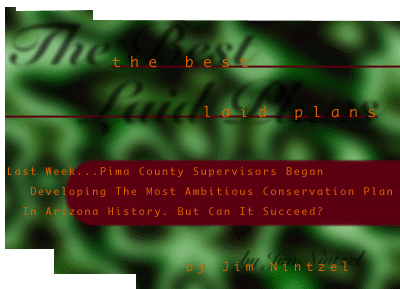
LAST WEEK, THE Pima County Board of Supervisors voted to
develop a radical conservation plan aimed at protecting endangered
species and addressing the effects of rampant, uncontrolled growth.
As drafted by a coalition of more than two dozen environmental
groups, the Sonoran Desert Protection Plan calls on the county
to work with local municipalities, the state and the federal government
to design an entirely new course of land planning in Pima County.
At its heart, the Sonoran plan creates a preserve of high-quality
Sonoran desert linked by wilderness corridors.
Can such a dramatic proposal succeed? To accomplish its goal,
the plan would essentially scrap existing zoning law and replace
it with a new set of strict development restrictions--which would
require approval from the conservative Arizona Legislature, which
has long been in the pocket of Arizona's powerful Growth Lobby.
 One skeptic of the Sonoran plan is County Administrator Chuck
Huckelberry, who recommended the county instead work with state
and federal wildlife officials to develop a multi-species habitat
conservation plan.
One skeptic of the Sonoran plan is County Administrator Chuck
Huckelberry, who recommended the county instead work with state
and federal wildlife officials to develop a multi-species habitat
conservation plan.
"I would like to have a publicly adopted Regional Multi-Species
Conservation Plan to submit as soon as possible--one that is real,
attainable, and sustainable, not just an unaffordable pretty picture,"
Huckelberry told the Board in a May 19 memo.
But the Board rejected his proposal and instead instructed county
staff to develop the environmentalists' Sonoran plan.
Any supervisor who saw Huckelberry following the meeting will
tell you he was upset with the Board's vote. One remarked, "I've
never seen him more unhappy."
Huckelberry himself plays down any hard feelings. "It's
the Board's decision, and we're going to carry out the Board's
direction. They make the policy, so that's fine. We're going to
implement that policy. If they change direction in the future,
that's fine, too."
But it's clear Huckelberry doesn't have much enthusiasm for the
Sonoran Desert Protection Plan. He's moved development of the
plan out of his office--which had been working closely with state
and federal wildlife officials--to the county's Parks and Recreation
Department, instructing Parks Director Dan Felix to figure out
how to pay for the first stage of the plan. And he's told the
coalition of environmental groups that developed the plan to outline
the work ahead for the environmental consultant who will begin
the surveys that will frame the Sonoran plan.
In other words, Chuck ain't gonna work on the Sonoran plan no
more.
THE SONORAN DESERT Protection Plan has been developed over
the last several months by a loose-knit coalition of Southern
Arizona environmental groups.
Carolyn Campbell, who serves as coalition director, says the
groups hammered out the proposal during weekly meetings. Campbell
has plenty of experience in politics. She served as an aide to
former Arizona Congressman Mo Udall, ran for the Arizona Legislature
on the Green ticket and most recently completed four years working
for former City Councilwoman Molly McKasson. She hopes the Sonoran
plan will allow science rather than politics to drive the environmental
agenda.
"The Sonoran Desert Protection Plan is not all that radical,"
adds Dave Hogan, a key organizer of the proposal. "What we're
talking about is a planning document which will outline the desert
preserve system, as well as areas where future development may
be appropriate."
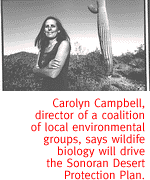 The Sonoran Desert Protection Plan calls for a biological survey
of Pima County to identify vital lands which contain washes, endangered
species and threatened plants. The most important land, linked
by biological corridors, would be set aside as the Preserve, in
which only single-family homes would be built.
The Sonoran Desert Protection Plan calls for a biological survey
of Pima County to identify vital lands which contain washes, endangered
species and threatened plants. The most important land, linked
by biological corridors, would be set aside as the Preserve, in
which only single-family homes would be built.
The Preserve would be surrounded by Buffer Zones, which would
include steep impact fees and other innovative financing mechanisms
to discourage development. Outside the Buffer Zones would be Urban
Sprawl Zones and Urban Infill Zones.
These zones would stretch across Pima County, including municipalities
which now are exempt from county zoning regulations because they
have their own zoning codes.
The 28-year-old Hogan, a staffer at the Southwest Center for
Biological Diversity who has been working on environmental causes
since he got out of high school in Southern California, maintains
his plan isn't that different from Huckelberry's.
"Our plan is the best," Hogan says. "His was better
than nothing. There were some bad components to it, but overall
he had a good idea, which was comprehensive planning for wildlife.
It was the wrong vehicle and he wasn't looking at enough funding
sources."
When it comes to funding, the coalition has been considerably
more imaginative than Huckelberry, although they haven't yet attached
a price tag to their project. "We're so early in the game
here it was even hard for us to say how much a consultant would
cost," he says.
In addition to a variety of federal funding sources, backers
of the Sonoran plan have come up with a wide range of funding
mechanisms--designed, plan documents explain, with a simple philosophy:
"All beneficiaries should be fairly assessed for the cost
of building the Preserve." Among the proposed new taxes:
- Open-space development impact fees. "Property owners
in all areas outside of the Preserve, possibly excepting those
within the Urban In-Fill Zone, could be required to pay open-space
development impact fees according to acreage impacted and type
of development," according to the plan document submitted
to the Board.
- Mitigation fees, which would force developers to purchase
20 acres of land within the Preserve and dedicate it to taxpayers
for every 10 acres of desert developed outside the Preserve.
- Real estate transfer taxes.
- New sales taxes, including a special tax on outdoor recreation
equipment.
None of these proposed financing mechanisms is currently legal
in Arizona, so the county and the coalition will have to successfully
lobby state lawmakers for enabling legislation. Coalition members
are hopeful the Legislature, which this year passed a law preventing
counties from even enacting a native plants ordinance, will accommodate
their agenda.
"Until February 24, we thought it was an impossible task
to get the Pima County Board of Supervisors on board for something
like this," says Campbell. "We have a lot of work to
do between now and then, but we're hoping for the best. We'll
cross that bridge when we come to it."
"I don't look upon the mechanisms for building the Preserve
as revolutionary, radical, or even visionary," adds Hogan.
"They are pragmatic and reasonable, and I can only hope that
reason will prevail not only at the local level but at the state
level."
Hogan even bristles at press characterizations of the Sonoran
plan as "taxpayer-funded," even though the proposal
calls for host of new levies from government.
"That's false," Hogan says. "One, we don't know
what it is yet, but two, our outline specifically lays out a method
for making the funding mechanism for this completely fair. Developers
will shoulder their burden, people who benefit from it, i.e. residents,
will shoulder their burden, visitors will shoulder a burden and
the state and the feds will shoulder their burden."
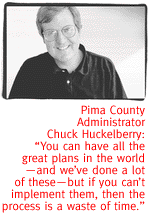 But aren't all of those groups made up of taxpayers?
But aren't all of those groups made up of taxpayers?
"Certainly the state and the feds are taxpayers, but developers--I
don't know if an open-space impact fee would be a taxpayer-type
thing," Hogan says. "That's not a local pocketbook expense.
We're not talking property taxes, and I'm certainly not pushing
a sales tax, although that's certainly an option."
Campbell says the coalition isn't necessarily attached to any
of the funding mechanisms they've proposed.
"We're not really making recommendations on any of that
funding stuff," Campbell says. "We were showing them
there were a lot of different options they can pursue. What we've
asked the county to do is look at all those different options
and also to look at any others they might come up with. But that's
going to be a bigger political decision in terms of what they're
going to suggest to the Legislature for changes. We're focusing
on the science part and we're asking them to look into these other
things because we would hope there wasn't going to be roadblocks
when it comes down to implementing them."
The plan's blurred features are frustrating to the pragmatic
Huckelberry.
"It's kind of like we have to interpret what it is and what
it means and how it gets put into the framework," Huckelberry
says. "The framework we always have to work with is called
the Constitution. It has to be legal, it has to be defensible,
it has to fit within the definition of property rights, zoning
law and all the history of things we've had to pay attention to
over the years.
The Sonoran Desert Protection Plan, says Huckelberry, "has
some things in there we don't know how to define right now, and
I don't know if those things fit in this constitutional definition
of traditional land-use planning law. I don't know what an Urban
Sprawl Zone is. I don't know if it's a building overlay or what."
FOR MONTHS, HUCKELBERRY'S office had been working with
the U.S. Fish and Wildlife Service and the Arizona Game and Fish
Department to lay the groundwork for his proposed multi-species
habitat conservation plan.
"We've actually been working to develop some rational approach
since the pygmy owl controversy began," Huckelberry says.
In hopes of preventing the controversial Endangered Species Act
battles that have hit communities in the Pacific Northwest, the
Clinton Administration has been pushing the U.S. Fish and Wildlife
Service to work out agreements with local communities on ways
to protect endangered species. The process allows communities
to develop conservation plans with federal officials that ensure
critical habitat is preserved while allowing development to continue.
Huckelberry hoped to ride that trend by creating a multi-species
habitat conservation plan with federal participation that would
have tried to provide protection for more than a dozen threatened
animal species, ranging from the jaguar to the pygmy owl, along
with several plant species.
"If you're in the rapidly developing area of the West, there's
probably a tendency to think about funding these kinds of projects
as--and a lot of people hate to hear this--a 'demonstration program'
to determine how an appropriate balance could be achieved between
preservation of the environment and attainable and reasonable
growth," Huckelberry says.
Essentially, county staffers hoped that, by marketing the plan
as a "model for the nation," they would open a steady
flow of federal dollars for land acquisition--absolutely key to
the success of any conservation project.
"While the early plans, often called Habitat Conservation
Plans, were funded primarily by the applicant, recent regional
efforts have involved federal and state government in funding,"
Huckelberry wrote in his memo to the Board. "One study indicates
that federal funding participation exceeds 50 percent.... The
same study of regional plans indicates the annual cost of such
programs begins at $20 to $30 million."
Huckelberry hoped to provide the county's share with bond dollars
from the recently passed open-space measure. He also hoped to
lobby the Legislature for the opportunity to ask Pima County voters,
who have lately been generous toward environmental matters, if
they would approve a quarter-cent sales tax for open-space acquisition.
Huckelberry's plan followed what he calls a "more traditionally
established" route.
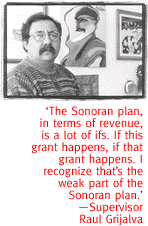 "If you look at what other communities have done,"
Huckelberry says, "that process is more amenable to achieving
a more attainable goal, which was to develop a plan and at the
same time develop probably the largest capability of bringing
in outside revenue sources that are going to be needed for implementation."
"If you look at what other communities have done,"
Huckelberry says, "that process is more amenable to achieving
a more attainable goal, which was to develop a plan and at the
same time develop probably the largest capability of bringing
in outside revenue sources that are going to be needed for implementation."
But Hogan argues federal funding doesn't require the route Huckelberry
has proposed.
"That's just a joke," Hogan says. "There's plenty
of funding available, as well as other sections of the Endangered
Species Act which specifically call for cooperation with states
on endangered species issues."
Hogan objects to Huckelberry's plan because he fears the county
will ultimately be given the authority to grant what's called
an "incidental take permit," which would allow developers
to escape penalty for harming an endangered species.
Hogan says Huckelberry's proposal played into the hands of developers
and the U.S. Fish and Wildlife Service, whose "agenda is
to only plan for wildlife conservation at the expense of the death
of endangered species," says Hogan. "We know an ulterior
motive is to provide developers with an out to the pygmy owl controversy....
One of the points, beyond just doing this comprehensively, is
to get the numbers of these endangered species up, such as the
pygmy owl, by acquiring essential habitat and specifically managing
to bring the numbers up--be that breeding programs, whatever it
takes. Then we can start talking about 'take.' "
THE SUPES, MEANWHILE, appear split in the wake of the vote.
Raul Grijalva, who made the motion to go with the Sonoran Desert
Protection Plan rather than Huckelberry's proposal, says he thinks
the Sonoran plan will be better for the environment, although
he admits Huckelberry's plan had better funding possibilities.
"It's easier money," Grijalva says. "(U.S. Secretary
of the Interior Bruce) Babbitt loves those things, so he'd be
handing out the cash to us."
But while he sees Huckelberry's plan as better from a financial
standpoint, Grijalva adds, "The debate is, would it really
be from an environmental standpoint? I thought the sure money
versus a little caution in terms of how we deal with those species
issues is more important to me. Let's try regulatory, let's try
a real, scientific-fact-based study, let's do all that kind of
stuff before we jump to sitting down and negotiating with the
feds and the developers about which is buildable and which is
not, and which species can go and which can't."
Grijalva says he wants to give the Sonoran plan a chance to work.
He's concerned that if the county develops both at the same time,
Huckelberry's proposal will get more attention than the Sonoran
plan, which, he admits, "needs more assistance, needs more
work, because of the uncertainty of how this is going to get funded....
The Sonoran plan, in terms of revenue, is a lot of ifs. If this
grant happens, if that grant happens. I recognize that's the weak
part of the Sonoran plan. The environmental and scientific part
is the strong part. The revenue's the weak part. In Chuck's plan,
the environmental stuff is the weak part and the revenue is the
strong part. I'd like to give the Sonoran plan a real opportunity
before we start resurrecting the other one. The other one's easy
to do, you just start putting in for those permits. It's not like
it's a complicated process."
Supervisor Ray Carroll, who was appointed to the District 4 seat
and is facing an election this fall, enthusiastically supports
the Sonoran plan.
"It sounds great that Chuck has identified his funding sources,
but I like that the Sonoran Desert Protection Plan has a coalition
that's fronting it that can serve as a buffer for Pima County
to go the Congressional delegation, and to other municipalities
or jurisdictions," Carroll says. "It's a citizen conservation
corps that was endorsed by the county Board, yet doesn't have
the baggage that the county Board has when approaching other municipalities
that we haven't had an excellent track record with as far as getting
cooperation. And it also gives them the opportunity to expand
and take on more volunteers and diverse groups interested in environmental
protection and a plan for environmental growth. I feel that coalition
has a great chance of going to Kolbe or McCain--we'll give letters
of endorsement--but I think they have the passion and the goals
that are clearer to them that aren't watered down by the bureaucracy."
He believes the environmental coalition will be more effective
at the statehouse than any lobbyist on the county's payroll.
"Paid lobbyists are always less effective than passionate
lobbyists who are doing it for their own goals and objectives,"
he explains.
But coalition members say they're counting on Pima County to
write the new legislation and lead the lobbying effort.
"Obviously, Pima County, now that they've endorsed it, has
more clout than the coalition," says Campbell.
Hogan agrees: "Obviously, the county has significantly more
power to effect the legislative process than grassroots environmental
organizations. That's just the way the power structure is. Not
only affecting the legislative process, but also approaching other
jurisdictions for participation."
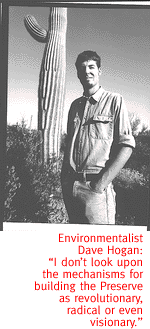 Sharon Bronson, elected to office in 1996 on a restrained-growth
platform, has misgivings about the Sonoran plan. She tried to
add an amendment to Grijalva's motion that would have directed
the county to develop both the coalition's and Huckelberry's plans
concurrently, but the motion failed.
Sharon Bronson, elected to office in 1996 on a restrained-growth
platform, has misgivings about the Sonoran plan. She tried to
add an amendment to Grijalva's motion that would have directed
the county to develop both the coalition's and Huckelberry's plans
concurrently, but the motion failed.
"I didn't want to block any of our options, and clearly
the plan the county administrator presented was fleshed out and
looked like something we could accomplish in the short run,"
Bronson says. "I didn't want to lock any avenues out. This
is too important an issue to let dogma drive a decision."
She ultimately voted to support the Sonoran plan, however, because,
"I think we need to have some overall plan in place and clearly
it was the will of the majority of the Board to do it this way.
I didn't want to be an obstacle. I just hope we can indeed move
forward with this plan, although I don't think there's buy-in
from the community on it at this point."
Bronson shares Huckelberry's concerns about the legal aspects
of the Sonoran plan.
"There are problems with the plan they submitted,"
Bronson says. "Their Urban Sprawl Zone--constitutionally,
I don't think we can do it. I would hope the coalition is talking
to their attorneys about the feasibility of some of their laudable
goals."
Bronson also says her contacts in the federal government tell
her the county may have flushed hundreds of millions of federal
dollars by rejecting Huckelberry's plans.
Huckelberry says there were never any guarantees of federal funding
with his plan. But he believes it had better odds of succeeding
than the environmentalists' alternative.
"You can talk optimistically about the $20 to $30 million
(annually), but you can't really pin anything down until you have
an appropriation," Huckelberry says. "All you can do
is talk about your probability of success in the appropriation
process, and that's always enhanced if you stay within the guidelines
established by the federal government for participating in that
process."
When it comes to federal appropriations, Pima County has a powerful
friend in Congress: Rep. Jim Kolbe, R-Dist. 5, is on the House
Appropriations Committee and is assigned to the Subcommittee on
Interior, which oversees federal wildlife funding.
Kolbe spokesman Ron Foreman, who hasn't seen either plan, says
he likes what he's read in the papers about the Sonoran plan.
"What's encouraging about the thinking of the coalition
is that they're looking at habitat in its totality and looking
beyond a single species," Foreman says. "The pygmy owl
has become symbolic of something much greater, and I think that's
a positive sign."
But Foreman cautions that federal money might not be as plentiful
as everyone seems to think. For starters, the Sonoran plan probably
wouldn't be eligible for Wildlife Refuge funds, which the coalition
has suggested.
"I don't think that's a good analogy for what we're trying
to do in an urban area," Foreman says. "That would not
be applicable."
Foreman isn't sure if any federal funds would be available to
support the Sonoran plan.
"We haven't gotten to that point," Foreman says. "I
think the idea of using locally generated funds probably makes
more good sense and is more do-able. Federal dollars come with
strings attached and there's a lot of bureaucracy."
THE DAY AFTER the vote, Hogan said the No. 1 priority for
the environmental coalition was to ensure Huckelberry didn't somehow
sabotage the Sonoran plan.
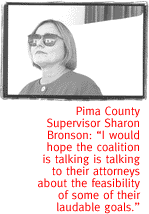 "We have about a million small steps ahead of us, and those
steps involve ensuring the County Administrator works with us
to carry out the Sonoran Desert Protection Plan instead of co-opting
our plan and making it what he wanted to do anyway," Hogan
said. "I think that's a huge likelihood. I don't think he'll
be successful, because we'll be watching him every step of the
way."
"We have about a million small steps ahead of us, and those
steps involve ensuring the County Administrator works with us
to carry out the Sonoran Desert Protection Plan instead of co-opting
our plan and making it what he wanted to do anyway," Hogan
said. "I think that's a huge likelihood. I don't think he'll
be successful, because we'll be watching him every step of the
way."
It turned out, however, that Hogan needn't have been worried
about Huckelberry subverting his plan--because the next day, Huckelberry
punted the plan out of his office, transferring responsibility
to the county's Parks and Recreation Department.
"It's most closely related to open-space regional planning,"
Huckelberry says. "That's what it would appear to be. They've
actually been working on things of that nature."
Coalition members, who hoped to meet with Huckelberry this week,
hope the Parks Department won't be the only county office working
on the Sonoran plan.
"We hadn't anticipated the Parks Department working on the
Sonoran plan as heavily as the planning department," Hogan
says. "Really, the expertise for what we're talking about
is in the Planning Department, so it's our hope it will eventually
be a cooperative effort between those two offices."
In the meantime, Huckelberry says his office will begin to work
on affordable housing and infill issues.
"We think we'll do as much work and research into that as
we've done in the multi-species habitat conservation planning
process," Huckelberry says.
Although he says "it wasn't something I would have recommended,"
Huckelberry refrains from criticizing the Board for the vote to
go with the Sonoran plan. Even so, there's a hint of disappointment
when he talks about the road not taken.
"We were after more than a pretty picture--something that
could realistically accomplish the goal and is attainable,"
he says. "You can have all the great plans in the world--and
we've done a lot of these--but if you can't implement them, then
the process is a waste of time."

|





